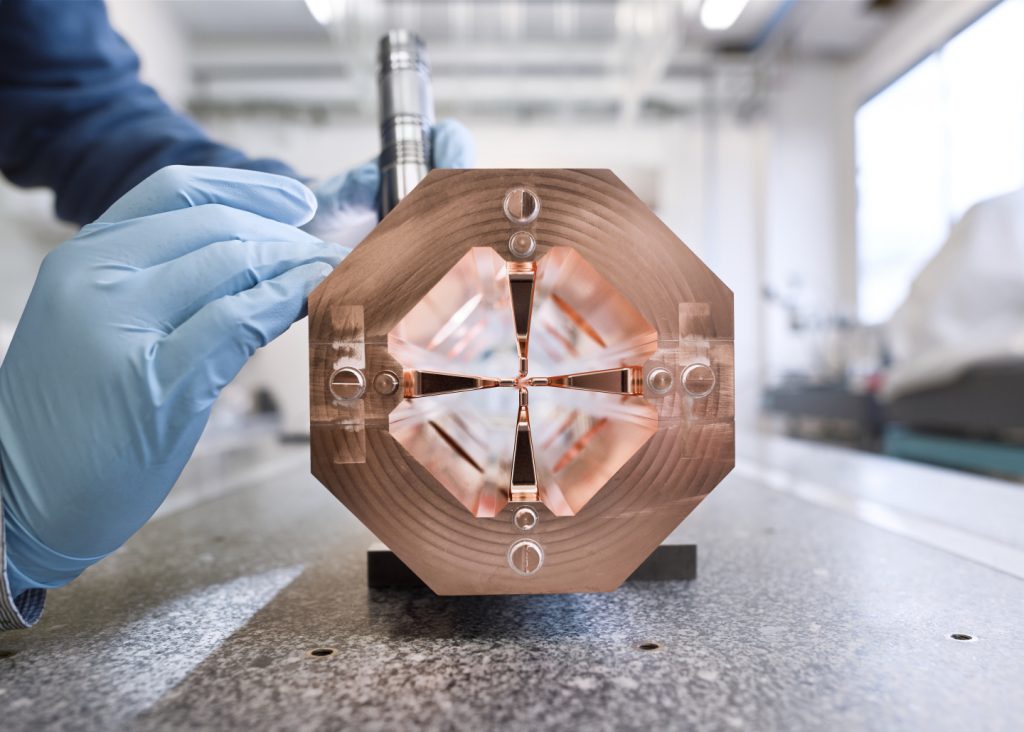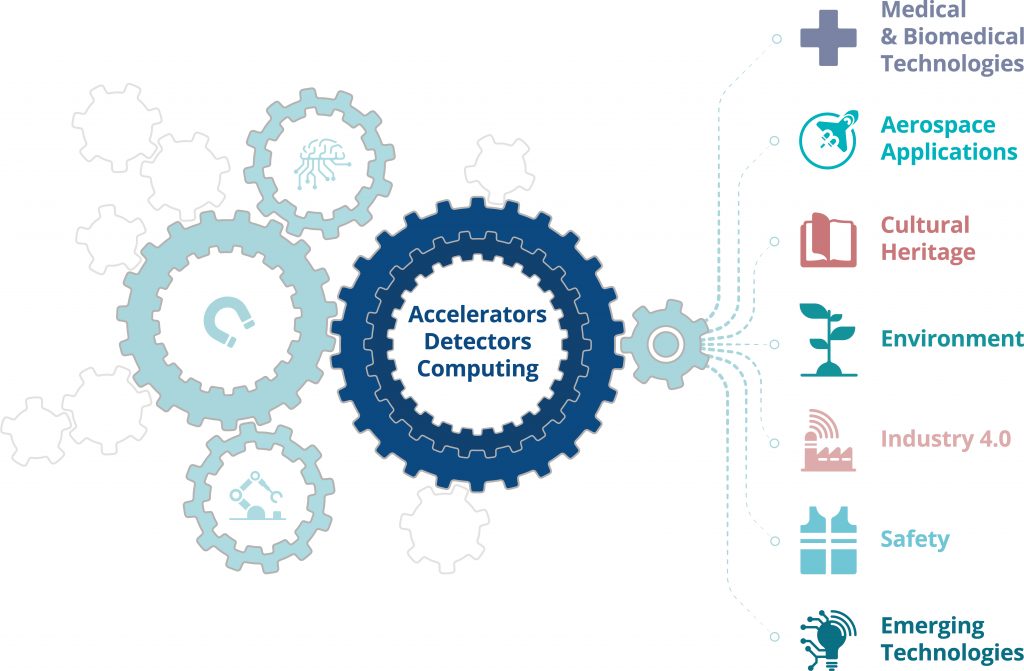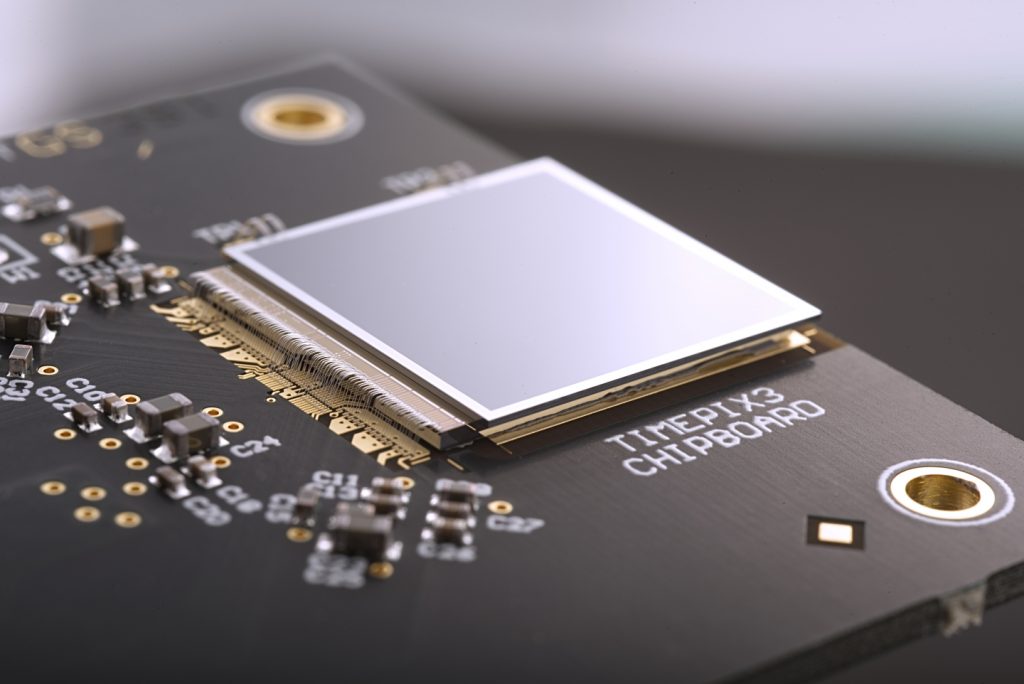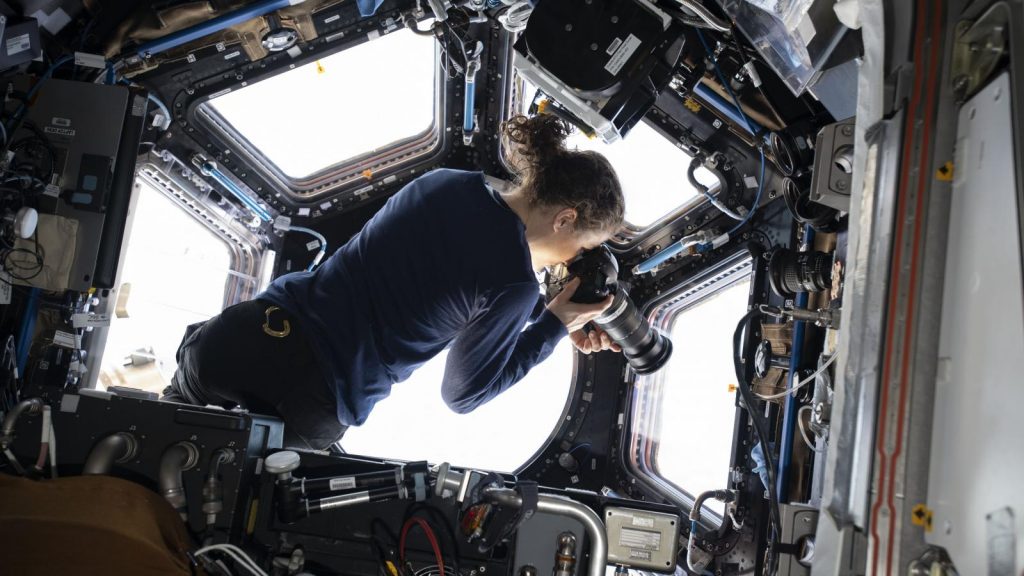
ACCELERATING INNOVATION WITH CERN
The CERN KT group creates opportunities for the application of CERN’s technology outside the field of particle physics, by leveraging the diverse expertise of its members in knowledge and technology transfer, science and technology, industry and entrepreneurship to create opportunities for the application of CERN’s technology outside the field of particle physics. Over the years, the CERN KT team has increased the visibility of CERN’s technology portfolio, with the goal of accelerating innovation and maximising the positive impact of CERN in society. As part of its knowledge transfer mission, CERN KT supports the application of CERN’s technology and scientists’ advanced skills and knowledge, in areas from medical treatment and diagnosis, electronics testing for aerospace applications, transportation, to even the authentication of centuries-old artworks.

From CERN to Society
In the mid-1990s, an informal collaboration of engineers and physicists from four institutes demonstrated the potential of a new technology to provide noise hit free single-photon counting, a breakthrough discovery to improve the identification of individual particles formed in collision events at CERN’s experiments. The collaboration quickly realised that adding a counter to each pixel and counting the number of particles hitting the sensors could allow the chips, called Medipix chips by the collaboration, to be used for medical imaging. Later, the Timepix chip, a variation of the former, added the ability to record the arrival time of the particles, or the energy deposited within a pixel, paving the way to new possibilities and new potential applications.
For the last 20 years, these two chips have been used in 3D colour X-rays, in spotting artwork forgeries, in detecting radioactive material, and in monitoring radiation at the International Space Station. This broad range of applications makes Medipix one of the most successful cases of technology transfer at CERN. It is also an excellent example of how technology developed for particle detectors, one of CERN’s technology pillars, can have applications in fields as diverse as medical and biomedical technologies, aerospace applications, environmental monitoring, and cultural heritage.

Medipix is only one of many technologies developed at CERN, made available for scientific and commercial purposes. The World Wide Web software is another such example, released under an open source license several decades ago. CERN’s technical expertise and innovative technologies are available to companies from large corporations to start-ups and academic partners, in a wide range of technical domains: magnets, sensors, radiation monitoring, cryogenics, vacuum, superconductivity, and more. CERN uses a variety of intellectual Property (IP)-based tools and solutions like collaborative R&D, the CERN Open Hardware License or patents, and has established a framework for its KT activities in an array of documents: its IP Policy and Spin-off Policy, for instance, lie at the core of successful knowledge transfer at CERN. This toolbox supports the Organization in disseminating its novel technologies, ensuring their application in a way that aligns with CERN’s values, and maximises their societal impact. CERN’s policy is to disseminate its technologies as widely as possible to industrial and institutional partners within its Member States and beyond.
Innovative solutions for a variety of industries
While the technology developed at CERN is highly customised for the needs of the Organization’s scientists and engineers, it is highly versatile as well. As illustrated by the Medipix example, technology developed for particle physics can have applications across a range of fields, some as surprising as cultural heritage. But it’s not only CERN’s state-of-the-art accelerator and detector developments that have important applications outside particle physics, nor is Medipix the only example of successful knowledge transfer at CERN. CERN’s proven experience in managing, storing and analysing large quantities of data is a differentiating factor in an increasingly digital society.
Two examples of the application of CERN’s computing expertise, developed together with increasingly more complex accelerators and detectors, in autonomous driving and in the protection of financial and commodity markets. When beams of particles are made to collide at the centre of a particle detector, new particles fly out in all directions. Different detector systems arranged in layers around the collision point use a range of techniques to identify the particles, generating an enormous flow of data. Complex data-acquisition systems and algorithms are used to analyse the vast amounts of collision events, and store and process the resulting data.
Similarly, the challenge in developing autonomous driving (AD) cars is the fast interpretation of the multitude of data generated in normal driving conditions. Zenuity, who develops software for automotive safety and AD, will explore how techniques deployed on chips called field-programmable gate arrays (FPGAs) could apply to AD. In that same line, the Commodity Risk Management Expertise Center (CORMEC) and Wageningen University & Research (WUR) will collaborate with CERN to use CERN’s expertise in advanced data analytics to identify anomalies that can harm the integrity of these markets, allowing governments and regulators to improve markets’ stability.
Contributing to a better planet
CERN taps into its technologies and creativity to address another enormous challenge: a healthier and more sustainable planet. Technologies developed at CERN contribute in areas from clean energy solutions to pollution prevention and agricultural optimisation. Since 2016, CERN is part of a research project to develop a system for optimised irrigation, based on technologies developed for the CMS (Compact Muon Solenoid) experiment at CERN. The irrigation system uses fibre-optic sensors designed to measure parameters such as temperature, humidity, concentration of pesticides, fertilisers and enzymes in the soil of cultivated fields. All developed hardware will be released under CERN’s Open Hardware Licence, and the software will be released under an open source licence within two years of the project termination.

The collaboration between CERN KT and different actors in the knowledge transfer ecosystem may take the form of collaboration agreements, encouraging entrepreneurship and spin-offs, participating in projects co-funded by the European Commission with a strong knowledge transfer aspect, and more. The resulting transfer of knowledge helps drive innovation for CERN’s economic impact in its Member States, as well as for society as a whole. One such case is the Horizon 2020 project ARIES, which aims to improve the performance, availability and sustainability of particle accelerators. In 2018, ARIES launched the Proof-of-Concept innovation fund for industry-oriented activities, awarding funding to four promising projects. One of these projects, coordinated by the Riga Technical University, proposes to reduce the content of sulphur and nitrogen oxides and of particulate matter in the exhausts of maritime diesel engines using an electron beam accelerator. In 2019, the first measurements confirmed the expected reduction in pollutants.
From CERN to Medical and Biomedical Technologies
As with autonomous driving and financial analysis, many breakthrough medical and biomedical technologies resulted from advancements in fundamental research instrumentation at institutions like CERN: radiotherapy devices deliver cancer treatment by means of particle accelerators, while Positron Emission Tomographs (PET) used in medical imaging contain photon detectors like the Electromagnetic Calorimeter at CERN’s CMS experiment. Continuing to support the knowledge transfer from particle physics to medical research and the medtech industry is a promising way to provide solutions to present and future health challenges.
One such challenge is the development of the next-generation of heavy-ion therapy machines, under the Next Ion Medical Machine Study (NIMMS), launched in 2019. NIMMS focuses on technologies related to superconducting magnets, linear particle accelerators (linacs), and gantries, technologies that fall well under CERN’s expertise. NIMMS will provide a toolbox of know-how to be adapted by end-users for a new generation of more compact and cost-effective ion therapy facilities.
Another such example is innovation in the field of radiopharmaceuticals, a group of medication that delivers a certain type of radiation. Innovation in this area is strongly connected with the availability of new isotopes with the most appropriate physical and chemical properties. Radioisotopes are widely used in precision medicine for medical imaging, diagnosis, and radiation therapy. The MEDICIS (Medical Isotopes Collected from ISOLDE) project uses protons from CERN’s accelerator ISOLDE to produce a wide range of innovative radioisotopes, some of which can only be produced at CERN. MEDICIS aims to increase the range of radioisotopes available for biomedical research, allowing researchers from the collaborating institutes to devise radiopharmaceuticals with the right properties for imaging and treatment.

From CERN to Aerospace Applications
The exploration of the smallest and largest structures of the Universe requires instruments and data systems capable of the highest achievable performances. Both space missions and underground accelerator and detector infrastructures have to deal with extremely harsh environments, posing technological challenges that often overlap. For this reason, a recent collaboration agreement between CERN and ESA will address the challenge of operating complex systems in harsh radiation environments.
Besides collaborative innovation, the similarity between space and particle accelerator requirements also makes laboratories like CERN the perfect set for testing equipment destined for space travel. The CELESTA cube satellite is a technological demonstrator that will validate in space a CERN technology called RadMon, which was developed to monitor radiation effects in the Large Hadron Collider (LHC). By using in low-Earth orbit a RadMon sensor previously characterized in CHARM facility, CELESTA will show that such technology could be deployed in space missions that are sensitive to radiation, from telecom satellites to navigation and Earth-observation systems, and at the same time that radiation hardness insurance can be performed at system level in CERN ground test irradiation facilities.
Similarly, NASA has adopted Timepix detectors, from the Medipix collaboration, to monitor the radiation environment on the International Space Station and in deep-space aboard the Orion Exploration Flight Test-1 (EFT-1). Smaller and lighter compared to previous NASA hardware, Timepix-based systems are ideal for space exploration missions and enable NASA to gather both the radiation dose and physical location of the radiation as it passes through the detector.
From Particle Physics to Culture Heritage
Cultural heritage takes many forms: from the tangible legacy of monuments, artwork and books, to digital resources, newly created or used to ensure cultural preservation. This heritage may not seem connected to CERN’s technological advances, yet the opposite is true. Particle accelerators, detectors, and dedicated software are used to analyse, authenticate, and preserve cultural artefacts.
For several years, accelerator technology has allowed researchers to authenticate artwork through their composition, without affecting the object under analysis. Together with the Italian National Institute for Nuclear Physics (INFN), scientists at CERN are developing MACHINA, a transportable accelerator that uses a compact radiofrequency quadrupole (RFQ): a miniature version of the first injector of the particle beam at CERN’s accelerator network. The beam created by the RFQ enables the identification of the elements present in a sample, helping researchers to ascertain if a piece is genuine. On the detector end, the start-up InsightART uses Medipix3 chips to study the composition of materials to determine the authenticity of pieces attributed to renowned artists. They have recently scanned an alleged Van Gogh, concluding the work was likely from the Dutch master. The piece will be sent to the Van Gogh Museum to be vetted with this new evidence.
A final example would be TIND, a CERN spin-off providing solutions for library management and data preservation based on the CERN open source software Invenio. The company have now permanently expanded their operations in the United States, opening an office in Palo Alto, California.
Fostering a Culture of Entrepreneurship
From all of the examples listed above, it becomes clear there are several ways CERN technology finds its way to society. One such way is through the variety of companies that collaborate with CERN to use CERN technology as a foundation for their business. CERN recognises the societal and economic impact of these start-up companies and supports entrepreneurs building new technology-based companies through the network of Business Incubation Centres (BICs). There are currently nine (9) BICs in Europe and 32 start-ups based on CERN technology. To further foster the entrepreneurship ecosystem CERN is part of, the CERN KT Entrepreneurship team organises two entrepreneurship programs as part of the Organization’s outreach mission. CERN Entrepreneurship Student Program (CESP) and Screening weeks are two programs where students from across the world come to CERN to explore applications of CERN technology outside of high-energy physics. On another hand, CERN’s human capital is one of its key strengths. CERN attracts talented staff and fellows from our member states and associate member states, many of whom could create great companies after the leave CERN. CERN KT aims to build a culture of entrepreneurship within the Organisation to develop and nurture this next generation of entrepreneurs, organising Entrepreneurship Meet-Ups (EMUs) to present topics to inspire new venture creation.
Research into the fundamental structure of the Universe requires innovative technologies for accelerators, detectors and computing systems, developed together with a variety of partners. The collaborations take a range of forms, including the application of technology in areas like medical imaging, autonomous driving, radiation monitoring, environmental solutions, and more. CERN KT will continue to address scientists, engineers, and industry to strengthen CERN’s positive impact in Society.
Daniela Antonio

Daniela believes true innovation is dependent on its outreach. For this reason, she pursued a career as a science communicator, hoping to make science accessible to everyone. With a undergraduate degree in Cell and Molecular Biology and a Master’s degree in Science Communication, Daniela has previously worked as a communications consultant, media analyst, translator and science communicator. At CERN, Daniela is the Communication Officer for the EU Projects Office, having started as an editor of Accelerating News in July 2018 and editor-in-chief as of June 2019.
 EN
EN